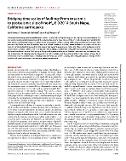Bridging time scales of faulting: From coseismic to postseismic slip of the M-w 6.0 2014 South Napa, California earthquake

Datum vydání
2022Publikováno v
Science advances [online]Ročník / Číslo vydání
8 (38)ISBN / ISSN
ISSN: 2375-2548Informace o financování
UK/GAUK/GAUK570120
UK/SVV/SVV260581
Metadata
Zobrazit celý záznamKolekce
Tato publikace má vydavatelskou verzi s DOI 10.1126/sciadv.abq2536
Abstrakt
Transient fault slip spans time scales from tens of seconds of earthquake rupture to years of aseismic afterslip. So far, seismic and geodetic recordings of these two phenomena have primarily been studied separately and mostly with a focus on kinematic aspects, which limits our physical understanding of the interplay between seismic and aseismic slip. Here, we use a Bayesian dynamic source inversion method, based on laboratory-derived friction laws, to constrain fault stress and friction properties by joint quantitative modeling of coseismic and postseismic observations. Analysis of the well-recorded 2014 South Napa, California earthquake shows how the stressing and frictional conditions on the fault govern the spatial separation between shallow coseismic and postseismic slip, the progression of afterslip driving deep off-fault aftershocks, and the oblique ribbon-like rupture shape. Such inferences of stress and frictional rheology can advance our understanding of earthquake physics and pave the way for self-consistent cross-scale seismic hazard assessment.
Klíčová slova
velocity frictional-properties, rupture, motion, deformation, behavior, rock, complexity, seismicity, inversion, parkfield
Trvalý odkaz
https://hdl.handle.net/20.500.14178/1676Licence
Licence pro užití plného textu výsledku: Creative Commons Uveďte původ 4.0 International







